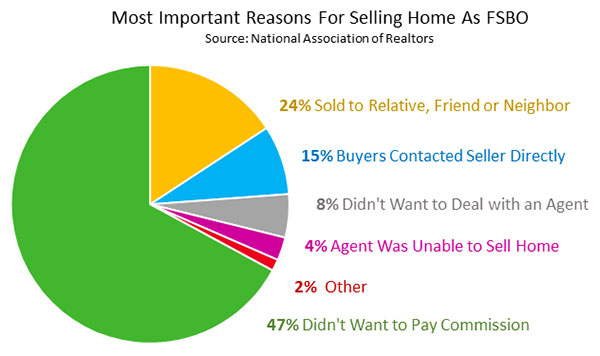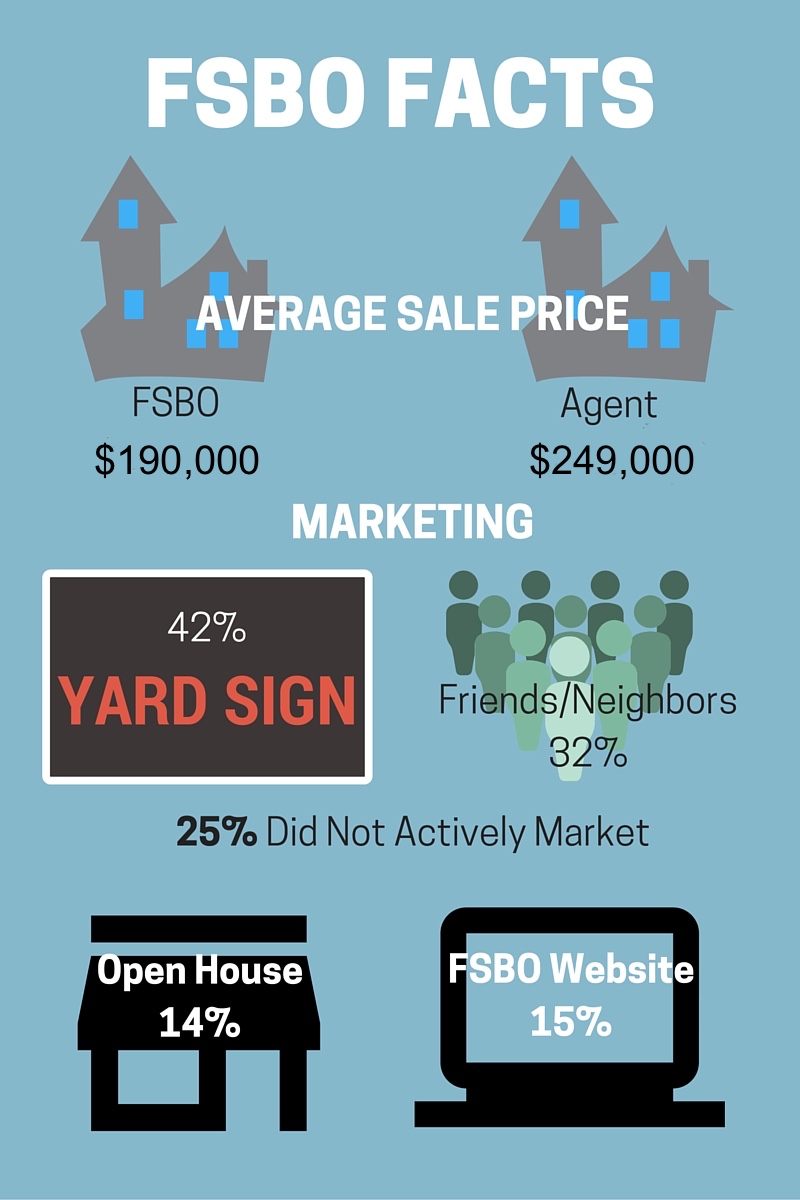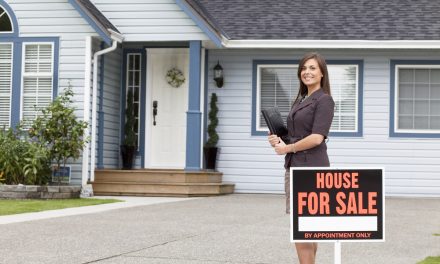FSBOs (For Sale By Owner) are notoriously difficult to persuade, but they offer new agents a valuable prospecting opportunity when listings are scarce. The issue is, most agents don’t know where to start.
Seasoned agents rely on a strategy for turning FSBO prospects into clients, and you too can develop a prospecting strategy targeted at FSBO in your farm.
In this article, we’ll share with you a strategy used by successful agents to add more FSBO listings to your sales funnel.
Converting FSBO: Understanding the FSBO Mindset
Prospecting is hard enough, but seeking out clients who expressly don’t want a real estate agent sounds like a recipe for failure, doesn’t it?
FSBO, however, is an underserved market. Most agents, in fact, would rather focus on expired listings.
The truth is, the overwhelming majority of FSBO are unprepared for the hurdles of selling their property in a timely manner. They also fail to sell their home for the desired asking price more often than sellers with representation.

Here are some common reasons why FSBO transactions fail:
9 Common Reasons FSBO Transactions Fail
- Asking price is too high
- Refusal to offer a buyers’ agent commission
- Can’t attract qualified buyers (directly related to the second reason)
- Not effectively qualifying prospective buyers
- Overlooking crucial documentation
- Low curb appeal
- Poor interior staging
- Failure to address issues raised by a home inspection
- Being present during open houses and showings
In reality, more than 80% of FSBO fail to sell their home successfully. This is good news for agents.
Take the time to build your prospect’s trust, and you won’t have to sell your services!
Advantages Of Prospecting To FSBO
- Have a qualified need to sell
- Tend to have a timeline in mind (13% found it a challenge)
- Lack of marketing experience
- Lack of negotiating skills (15% found it a challenge to get the right price)
Cons Of Prospecting To FSBO
- Unwilling to pay a commission
- May have strong objections or resist advice
FSBO Facts (NAR 2017 Report)

- 8% of FSBO listings use an MLS website
- 28% do not ACTIVELY market their home
- The average FSBO home sells for $59,000 less than realtor®-assisted sales
- 12% of FSBO have difficulty understanding all the documentation required to sell their home
5 Tips for Converting FSBO
- Do not approach FSBO listings on the MLS. There are many more who are not. And those who are have been solicited to already. You’ll just be another agent.
- Check newspaper listings, Craigslist, and yard signage for prospective FSBO opportunities. They are more eager to sell because they are spending money to advertise.
- Meet with your prospects in person FIRST. Most of your competitors will be calling. Don’t be just another annoying phone call. Go the extra mile and visit them in person
- Expect to meet with your prospect 3 – 5 times before you win their business.
- Don’t sell your services, be of service!
The last tip is really important. Sales isn’t really about selling at all. It’s about uncovering a need and being of service.
Listen to Ben’s story from TwentyNewClients.com, a YouTube channel dedicated to real estate coaching tips:
When you find solutions that make your prospect’s life easier, you won’t need to sell your services. They’ll trust and respect you enough that you’ll earn their business.
The key points of this strategy were first shared by Century 21 agent, Jon Higgins. In his article for ActiveRain.com, he describes how he implements this strategy with a 70% conversion rate!
Are you ready to be of service and stand out from your competitors? Then follow our advice for an effective FSBO strategy.
4-Part Converting FSBO Prospecting Strategy
Stage 1) Research
Research your FSBO market. Drive around and identify any FSBO opportunities in the neighborhood. Add their contact info to your CRM.
Focus on properties that have a yard sign. 35% of for sale by owners will invest in a yard sign. This is a strong signal of the seller’s desire to attract a walk-in business. It also establishes a logical reason for your visit when you show up unannounced to introduce yourself, in the next stage.
Check out online classifieds as well for homes that have been on the market for 1 month or more. The longer the FSBO property has been on the market, the more urgent their need to sell will be.
Stage 2) First Visit
Having identified properties with yard signage, visit each FSBO in person. When you do, simply introduce yourself. Do not mention how you discovered them. Instead, let them know you work with buyers and happened to notice the yard signage.
Then, ask the FSBO a simple question:
“Would you mind telling me what your buyer broker agreement rate is?”
New for sale by owners won’t even know what you’re talking about. That’s your opportunity to be of service and build rapport by explaining what it is. Explain to them that having one can attract qualified buyers.
If the prospect has an agreement in place, follow up with this question:
“I’m enroute to a meeting with prospects, but I’d like to come back for a viewing at another time, so I can let people in my circles know. Would that be OK?”
DON’T schedule a time on the spot. Take their contact information and promise to contact them as soon as possible.
Just before you leave, ask one final question:
“Do you have all your legal disclosures?”
Again, they will likely have no idea what you’re talking about. Tell them that you will provide them with all the state-required disclosure and lead-based paint documentation. Your prospective FSBO will be grateful for your free help and advice.
Even better, you’ll establish yourself as a knowledgeable expert in their eyes, and build anticipation for your follow-up call/email.
Now that you’ve established contact and positioned yourself as an expert, we move to the next stage.
Stage 3) Second Visitation
If your first introduction was a success, your second meeting should be met with more interest and enthusiasm. Remember to send them the legal disclosure documents by email and a thank you for taking the time to speak with you.
Follow up in-person within 3-4 days of your initial visit. Have all the documents printed and ready to deliver, even if you emailed them. If you don’t reach them in person, keep trying till you do.
On your second visit, you can ask to view the home. When you do, be sure to compliment the FSBO on each room. Find something positive to comment on, but take note of the less attractive features as well.
If, for example, you notice shoddy grout work or a loose drawer handle in the kitchen, don’t point it out to the owner.
Instead, keep track of anything that could negatively impact their asking price. You can use this insight at a later date to persuade them to either lower their price or invest in repairs/reno work.
Rather than discuss the defects, ask your prospect 3 critical questions:
“So, what are you doing to get exposure?
“What kind of response have you had so far with your marketing?”
“Would you like to know how I would market your home if I were YOU?”
The last question, again, is very important. Make the conversation about the homeowner, not your services. Use this conversation to share your listing presentation in a casual manner.
When you finish sharing your marketing strategy for selling their home, leave them with your card. Provide them with additional resources to help them sell their home – for free. Thank them again for their time, and remind them gently that you would love to sell their home when they’re ready.
Remember, the key is not to appear pushy or overzealous. If someone is wanting to represent the property themselves, they clearly don’t want to be sold. You simply need to build their trust by being consistent, courteous, and persistent.
Stage 4) Third Visit
Don’t expect your phone to ring off the hook after your visit. Converting FSBO as a strategy, takes time to cultivate. Schedule a time in your calendar and follow up in person with your prospect 1 week later.
When you visit, find out if there has been any change in their marketing since your last discussion. Find out if they have any prospective buyers lined up.
Finally, offer them additional resources to help them sell their home. Whether it’s a free staging guide, a helpful contact, or a legal document (area board contracts, disclosures, etc), be sure your offer is relevant to their need.
At this point in your relationship, the FSBO will either be warmed up to you or resistant. You’ll certainly have enough information and rapport to determine the likelihood of closing the listing.
If you are not getting any buying signals from your prospect by your third visit, either:
- the prospect did not find you helpful
- the seller is not open to a buyers’ agent commission
Add them to your contacts and schedule follow up actions with them by email (with permission, of course).
That’s it! Straightforward, simple and direct, this prospecting strategy can be tweaked any way you like.
The best part of this strategy is that you won’t ever have to ask directly for their business until they’re ready to sign a listing agreement.
And, while it will take several visits, your consistency and persistence will build trust, making you the most likely choice when they are ready to list.
Converting FSBO: Summary
Persistence, consistency, and professionalism are the keys to converting FSBO. Instead of soliciting them with promises of outstanding results, be of service.
While other agents are cold calling or emailing MLS prospects, go the extra mile to visit a FSBO who hasn’t yet listed their property for sale. They represent an underserved market, and you’ll face less competition.
Rather than a formal listing presentation, offer your expertise, advice, and contacts to help the FSBO for free. Remember, their odds of selling without an agent are less than 20%. Even with your free support, they are unlikely to follow up on your advice, but they will be impressed by your insight.
Lastly, be prepared to invest more face time in converting FSBO than any of your other lead sources. If you’re a new agent searching for listings, consider making FSBO your niche.






